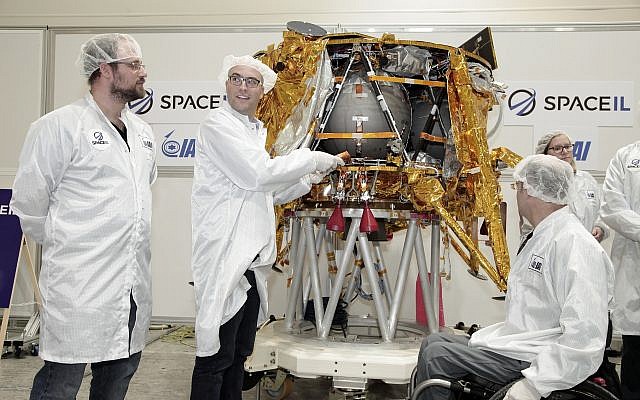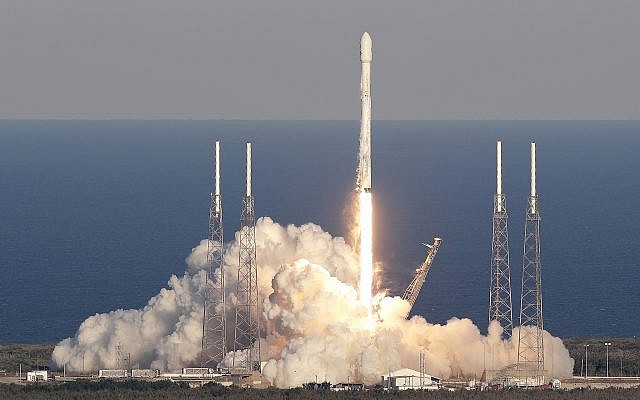With sights set on the moon, Israel to launch privately funded spacecraft Friday
Beresheet set to touch down in the Sea of Tranquility on April 11; $100 million project, paid for mostly by Jewish donors, would make Israel 4th country to land a craft on the moon
By MELANIE LIDMAN, TOI 18 February 2019,

Yariv Bash, right, Yonatan Winetraub, middle, and Kfir Damari, the founders of SpaceIL, inserting a digital time capsule into the Beresheet spacecraft, December 17, 2018. (Yoav Weiss)
Israel hopes to become the fourth country in the world to land a spacecraft on the moon, with the launch of the unmanned spacecraft Beresheet from Florida’s Cape Canaveral this Friday. If successful, the 160-kilogram (350 pounds without fuel), four-legged spacecraft will also be the smallest and cheapest spacecraft to land on the moon.
The $100 million (NIS 370 million) spacecraft is a joint venture between private companies SpaceIL and Israel Aerospace Industries, funded almost entirely from private donations from well-known Jewish philanthropists including South African billionaire Morris Kahn, Miriam and Sheldon Adelson, Lynn Schusterman, and others.
Previously, Russia (as the Soviet Union) and the United States have landed on the moon. China landed an unmanned spacecraft on the far side of the moon in 2013.
Beresheet will lift off from Cape Canaveral at approximately 3:45 a.m. IST on Friday (8:45 p.m. Thursday EST), catching a ride on one of Elon Musk’s SpaceX commercial space launches.
Once airborne, the spacecraft will detach from Musk’s Falcon 9 rocket after about half an hour and begin its seven-week journey to the moon. Beresheet will circle Earth six or seven times in a series of growing ellipses before jumping into the moon’s orbit on April 4.
Beresheet will land on the moon in between the detritus left from the Apollo 12 and 15 missions in the Sea of Tranquility, on April 11 around 8 p.m., give or take an hour, according to SpaceIL CEO Dr. Ido Anteby.
“This is the first mission of a small country to the moon, but it’s a non-government mission to the moon, which is privately financed,” Anteby said on Monday at a press conference in Tel Aviv ahead of the launch. “It will open new horizons to the moon for commercial opportunities.”
“Usually, these kinds of projects come from government agencies of major superpowers,” Anteby added.
SpaceIL was the only Israeli contestant in the international Google LunarX PRIZE competition, which offered participants a chance to win $20 million by landing an unmanned spacecraft on the moon. Google ended the contest officially on March 31 with no winner. But the group behind SpaceIL decided to continue its mission, turning to donors to help fund the bare-bones operation.
The Beresheet spacecraft will measure magnetic fields on the moon, data which will be transferred to the Weizmann Institute to help scientists study how the moon was formed millions of years ago. Beresheet will send information for approximately two to three days before the sun’s rays are expected to melt parts of the communication system, ending the mission.
Although scientists are interested in the hard data that Beresheet is expected to gather, Dr. Ofer Doron, the general manager of the Space Division at Israel Aerospace Industries, said one of the main goals of the spacecraft is education.
The Beresheet team hopes that the excitement around Israel’s first moon landing will have an “Apollo effect,” when space travel in the 1960s inspired hundreds of thousands of children in America to study science and aerospace engineering.
“The most exciting part is getting Israeli kids super excited about technology, to see that they can do everything,” said Doron. “It’s a great technological achievement, but it’s also a huge educational achievement.”
The Beresheet team is rolling out a number of educational initiatives along with the Education Ministry to help students follow the spacecraft’s journey, including special kits for teachers and a free smartphone app.
President Reuven Rivlin will host a pajama party with students on Thursday night, staying up until 3:45 to watch the launch at the President’s Residence in Jerusalem. The project employs more educators than engineers, in an effort to ensure that the spacecraft’s journey and moon landing reach as many students as possible, said Daniella Geron, a ground segment system engineer responsible for coordinating between the various teams and the spacecraft.
The spacecraft is carrying a Hebrew Bible inscribed with nanotechnology on a small metal circle the size of a 5 shekel coin, and a time capsule with Israel’s Declaration of Independence and national anthem, the memories of a Holocaust survivor, children’s drawings of space and the moon, the Traveler’s Prayer and a note from the late former president Shimon Peres.

The Beresheet Command Center is in Yehud, about 10 miles southeast of Tel Aviv, where the spacecraft was built and tested, including spending 10-day periods in a massive vacuum that blasted the spacecraft alternately with extreme heat and cold in order to ensure it can stand up to the wide temperature fluctuations in space.
In order to cut down on cost and weight, the Beresheet does not have duplicate systems. Most spacecrafts carry duplicate solar panels, communication systems, and other technology, so that if there is a failure, the backup system can kick into place and the mission can continue. With Beresheet, if any piece of equipment fails, the whole project is lost.
Beresheet will travel at speeds of 36,000 kilometers per hour. When it is at its farthest point, approximately 400,000 kilometers away from Earth, the team will be able to communicate with the spacecraft only if Beresheet’s location can be pinpointed within a few meters. A team of engineers is currently training with NASA satellites to help prepare them for the lunar landing.
The team will have just one opportunity to land on the moon, though it might be able to try again if it misses the first window, Anteby said.
The project almost didn’t happen, a near-casualty of US President Donald Trump’s extended government shutdown. The spacecraft was packed and ready to go in Israel in late December, but still waiting for customs clearance, when disagreements over Trump’s border wall shuttered the American government for 35 days.
If Beresheet hadn’t arrived in America in time to be assembled for the SpaceX launch, the entire project would have fallen apart, said Morris Kahn, the 89-year-old president of SpaceIL. Kahn worked a number of contacts to obtain approval from US Customs despite the government shutdown, and the spacecraft arrived in Florida in time to make the launch.
The moon landing also opened new avenues for cooperation with Israelis and NASA, which is excited about the project’s low cost and hopes to make it a prototype for future moon landings if the operation is successful.

“How much hutzpah [arrogance] is it to think you can get to the moon with $100 million?” Doron asked. “Maybe we should have named it hutzpah instead of Beresheet.” The public chose the name Beresheet, the Hebrew name of the Book of Genesis, in a poll run by SpaceIL in July 2018.
SpaceIL and Israel Aerospace Industries have also signed agreements with German space agency OHB in addition to NASA.
“There is a trend that now a lot of space agencies want to go back to the moon, so there’s an opportunity here for commercialization,” said Doron. He noted that Israel’s moon landing will bring enhance national pride as well as bring commercial opportunities.
Space travel is going the way of Uber and the sharing economy, with international space agencies looking to cut costs by using “ride shares” to hitchhike into space on existing commercial launches.
The Falcon 9 rocket launch that brings Beresheet into space will also launch a large geo-communication satellite and other equipment for the US Air Force. While Musk has cornered the market on commercial rocket launches, SpaceIL and IAI are hoping to find a niche in inexpensive moon landings, so space agencies or, one day, private individuals or organizations, could send cameras and research equipment to the moon for their own purposes.

For now, though, the team of engineers and educators has their eyes set on April 11, which is conveniently after Israel’s elections, set for April 9.
Doron said the Beresheet team chose the date before Prime Minister Benjamin Netanyahu called elections.
For now, the 25 engineers are in crunch time, making last-minute adjustments before Friday’s launch.
“We will have about half an hour of contact with the spacecraft every four hours,” explained Geron, the coordinating engineer. Beresheet’s team will use satellite dishes spread across the world in Hawaii, Chile, Sweden, Australia, South Africa, Germany, the continental United States, and Israel, to track the spacecraft, using satellite dishes with diameters of up to 74 meters (240 feet), Geron said.
She noted that the project is about more than just the data they hope to gather about the moon’s magnetic field. “It’s about gaining knowledge that will stay in Israel,” she said. “Everything we went through, all of the connections, all of the late night emails, we learned so much and next time it will be faster and more efficient,” she said. “We needed to find so many creative solutions, ways to make the communication work as the spacecraft is moving and we are moving. We are accumulating all of this knowledge, and also the education branch will inspire so many children.”
Geron said when the engineering team needed a break from the intensive work, they would head out to schools to give lectures about the project, and come back inspired by all of the interest generated by the Beresheet project.
“The moment we connect with the spacecraft after landing, we’ll be able to breathe again,” said Geron. “And it will all be worth it.”



Leave a Reply
You must be logged in to post a comment.